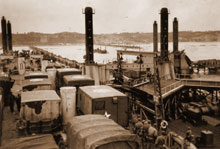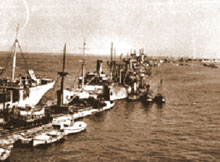Mulberry A and Mulberry B
Mulberry Conception
The two artificial ports which were to be installed, to supply the troops after the Landing on the Normandy Beaches were given code names Mulberry «A», for «American» and Mulberry «B», for «British». The choice of this name was totally fortuitous. It covered the entire operation of the harbor, other code names were given to the various elements. The purpose of the Mulberries was to provide sheltered water for shipping and, secondly, help with unloading the cargo. The shelter structure was composed with concrete blocks (Phoenixes) sunk in line offshore, reinforced with a line of floating steel tanks in a cruciform shape (Bombardon) moored about three miles out of sea. The unloading facilities were set up with floating pierheads which were able to follow the rise and the fall of the tide (Spud Pontoon or Lobnitz Pontoon), connected to floated piers (Whales) supported by steel and concrete floats (Beetles) all moored with anchors into the seabed, and connected to shore.
A few months before D-Day, it was decided to widen the area for the assault. A previous harbour in a curved shape had to be studied (Gooseberry), it was to be made of old cargo ships (Corncobs) which will be scuttled after they were placed into position on the far shore under their own steam. Five gooseberries had to be set up facing the five landing Beaches, they were also named the Blockships.
The strategic situation convinced the Prime Minister, Winston Churchill, to promote plans for this project. The intermediary was Admiral Lord Louis Mountbatten, the Chief of Combined Operations.
Mountbatten's team was Col. Bruce White, Col. Steer Webster, Brigadier (later Major General) Harold Werhner, Admiral Hughes Hallett, and Admiral Harold Hickling.
The War Office was responsible for Ports, the construction and the maintaining was to be given to civil Engineers and the Admiralty was responsible for the shipping operations. The plans for landing in Normandy were almost achieved and were code named Overlord.




They were checked out and were accepted by the Prime Minister, the President and the Chiefs of Staff at Quebec in August. En route to North America, on board the Queen Mary, Mountbatten gave a lecture. Several senior officers were regrouped in one of the luxurious bathrooms of the ship for a demonstration given by Professor J.D. Bernal, an eminent physicist and one of Mountbatten's scientific advisers. Standing on a lavatory seat, Admiral Sir Dudley Pound, First Sea Lord, invited his colleagues to imagine the shallow end of the bath as a beachhead; Bernal now floated, with the assistance of Lt-Cdr D. A. Grant, a fleet of twenty ships made of newspaper. Grant was then requested to make waves with the aid of a back brush. The fleet sank. Area West lifebelt was then inflated and floated in the bath so as to represent the harbour. The fleet of paper boats were then placed inside it. Once more Grant applied his brush vigorously to create waves, but this time they failed to sink the fleet. As much importance was, of course, the requirement of facilities for discharging cargoes.
The crossing and the setting up
On Sunday, June 4 these were two US wooden submarine chasers, which were the flagships for Clark and Stanford in the Solent .The landing had already been delayed by Eisenhower of twenty four hours. In the afternoon of June 6, right after the troops had landed in Normandy, the order was given to the Mulberry Force to sail.
The Mulberry B was the first one across because the enemy opposition, apart from mines, was not so bad in comparison to Omaha. The American had to fight hard to progress inland and to prepare a suitable beach to set up their Mulberry A. The beach clearing was done by the veteran 531 Engineer Shore Regiment of the US Army. The first Blockships arrived on June 7. Gooseberry 1 was for Utah. The operation was conducted by Stanford and stopped by the fire of German guns. The «Wason» was the first ship to be scuttled, she swung round because the tugs skippers anxious about the German shelling, cut loose too soon. To underline, how risky their situation was, the second and the third ships were sank by the Germans. Who confirm their destruction later to Radio Berlin. Fortunately they were set down on their approximate previous site. Stanford worked on the opportunity and decided to shape two curves with the other ship sunk accordingly. On June 13 Gooseberry 1 was completed and was able to accommodate 75 Liberty Ships and masses of small crafts.
Two causeways were made of Rhino ferries Pontoons, with one of them extending beyond the Gooseberry. Then the troops could land «dry» and small craft could moor and unload alongside them.
Goosberries and Phoenix
Gooseberry 2 provided the first shelter for craft discharging in Mulberry A. In order to allow rapid access to the beach for light craft, the Americans decided that two gaps should be left between the ships, in effect making three breakwaters. Royal Navy Officers had warned that the sea would pour through the gaps in bad weather, which was proved correct when a storm blew up on June 18. Cdr. C. R. Dennen, USNR, directed the scuttling operation and the great bulk of Centurion provided a cornerstone to the breakwater. The next three ships, «James Iredell», «Baialoide» and «Galveston», were sent to the bottom under sporadic gunfire from inland; however, the Gooseberry was completed by June 10. Here too, a pontoon causeway was erected by the Seabees opposite the Saint-Laurent exit and was in use by that date. At Mulberry A the Bombardons were laid by Cdr. L.D. Ard, USNR.
That breakwater was a mile long and composed of twenty four Bombardons, completed by June 17. The first two Phoenixes arrived on June 10; they were delayed due to the enemy fire, then in the next four days a batch of thirty two of the fifty one units planned were sited and start to provide a breakwater. As the Blockships, they were not always easy to sink. Several units cut loose of their tugs.
The Americans experienced a more dangerous start to their pier construction than the British. They had to work under the range of snipers and there were more obstacles than in the British Harbour area. Although tows began to arrive on June 9, construction did not start until June 12. Clark therefore decided to concentrate on completing the center piers, combining a stores pier with an LST pier, as it was important that tanks should be brought ashore to cut off the Cherbourg peninsula and advance inland.
Work now went ahead with the utmost speed under the direction of Lt. W. L. Freeburn and his assistant, Chief Bos'n F. F. Hall.
British and Americans: two different points of view
While there was no doubt that the work of the Seabees was good, their initial work on the equipment in Scotland had begun too late for them to benefit from actually linking the spans and anchoring the floats themselves, and this task was completed by the British.
Moreover, the officers who had been sent on the courses did not seem to appreciate, in the way that the British did, the need to secure the floats properly. Later they turned a deaf ear to Beckett's warnings, and training before D-Day was, in any case, limited to coupling a few spans.
For this reason, the Americans thought that the mooring of alternate spans would be enough, but when the bad weather came the anchors dragged and the spans swung out of position. The British, on the contrary, doubled their moorings when the gale warning was given.
It is true, however that the American harbour was more exposed than the British and the worst factor was the sea bed, where it was impossible to obtain a suitable anchoring. Like the Americans, the British suffered from the loss of tows during the Channel crossing.
Ellsberg was already on the beachhead waiting for orders to clear the Port of Cherbourg. Clark asked him whether it would be possible to use the lighter floats, intended to carry a 25 ton load, for the Sherman tanks of the 2nd US Armored Division weighing 38 tons. Or would they submerge under the strain? Ellsberg, who had a slide rule with him, set to work to measure a float and then spent most of the night alone in Clark's headquarters ship cabin working out the problem. He was able to reassure Clark's headquarters ship cabin working out the problem, which finally get's solved.